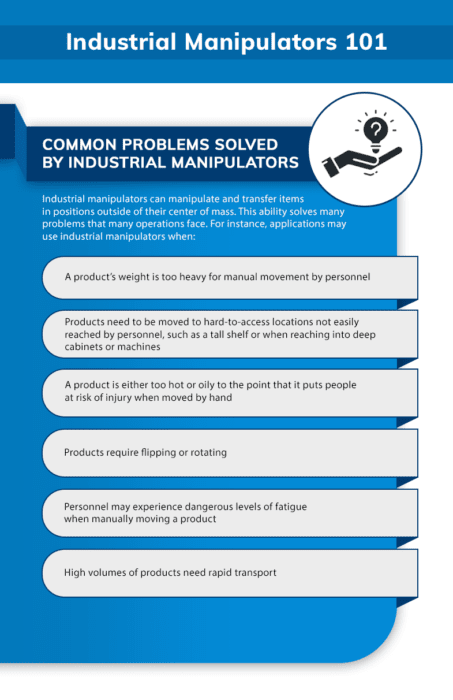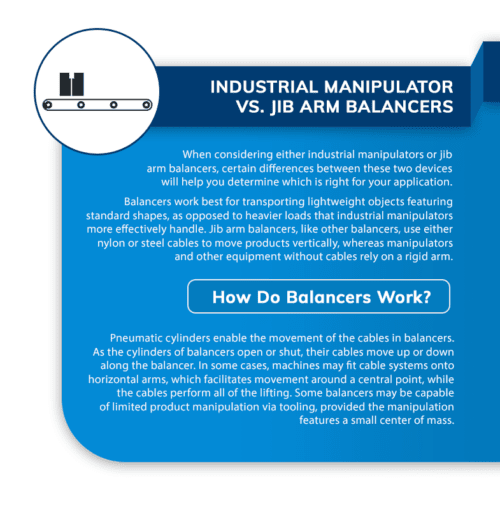Industrial manipulators are lift-assist devices that take the stress of repetitively lifting heavy or bulky items off personnel. Routinely lifting and transporting heavy items presents workplace safety risks and has the potential to cause musculoskeletal issues for workers due to improper lifting techniques and fatigue. These devices help workers across a variety of handling operations, allowing users to complete handling tasks with consistent safety, convenience, and efficiency.
Industrial manipulators are designed to mimic the movement of human hands, wrists, and arms for optimal performance, and they are available in portable, floor-mounted, and overhead-mounted models. As industrial manipulators assist with material handling and ergonomic lifting, they will subsequently reduce fatigue, help minimize the risk of injury, and increase overall productivity.

Common Problems Solved by Industrial Manipulators
Industrial manipulators can manipulate and transfer items in positions outside of their center of mass. This ability solves many problems that many operations face. For instance, applications may use industrial manipulators when:
- A product’s weight is too heavy for manual movement by personnel
- Products need to be moved to hard-to-access locations not easily reached by personnel, such as a tall shelf or when reaching into deep cabinets or machines
- A product is either too hot or oily to the point that it puts people at risk of injury when moved by hand
- Products require flipping or rotating
- Personnel may experience dangerous levels of fatigue when manually moving a product
- High volumes of products need rapid transport
Industrial Manipulator vs. Jib Arm Balancers
When considering either industrial manipulators or jib arm balancers, certain differences between these two devices will help you determine which is right for your application.
Balancers work best for transporting lightweight objects featuring standard shapes, as opposed to heavier loads that industrial manipulators more effectively handle. Jib arm balancers, like other balancers, use either nylon or steel cables to move products vertically, whereas manipulators and other equipment without cables rely on a rigid arm.
How Do Balancers Work?
Pneumatic cylinders enable the movement of the cables in balancers. As the cylinders of balancers open or shut, their cables move up or down along the balancer. In some cases, machines may fit cable systems onto horizontal arms, which facilitates movement around a central point, while the cables perform all of the lifting. Some balancers may be capable of limited product manipulation via tooling, provided the manipulation features a small center of mass.
Industries for Industrial Manipulators & Jib Arm Balancers
Depending on the needs of different applications, facilities may use either industrial manipulators or jib arm balancers for improved material handling capabilities. Some specific applications for these devices include:
- Building: Applications in the construction and building manufacturing industries frequently use industrial manipulators to assist with handling a variety of materials, including drainage pipes, paving slabs, concrete products, and many other heavy loads.
- Packaging and Packaging Lines: In many cases, companies in the packaging industry will need to move products of varying sizes and shapes, such as pallets, boxes, drums, and plastic rolls. These and other products require lifting solutions that are dependable, adaptable, and versatile for use with many types of products.
- Textiles: Textile applications rely on industrial manipulators to handle rolls of different materials and sizes.
- Chemistry and Foundry: These industries often use industrial manipulators to handle and lift a variety of hazardous chemicals to minimize the risk of exposure to employees. Foundries may also use industrial manipulators to handle other heavy items, including crucibles, foundry buckets, molds, rims, foundry pieces, and precision castings.
- Food: Industrial manipulators carry many food products such as whole cheeses and other dairy products, meats, bottles, processed food packaging, food bags, and carton boxes.
- Mechanics: Industrial manipulators’ rigid steel arms can complete a multitude of tasks that involve complex pneumatic rotations and tilts.
- Wood: Industrial manipulators’ capabilities also enable them to carry and handle many wood products of varying shapes, sizes, and weights.
- Electromechanics: The electromechanical industry frequently experiences ergonomic problems due to the frequent handling of bulky products. Industrial manipulators handle and carry electromechanical products such as tubes, TVs, appliances, and air conditioners, among others.
- Automotive: Large and heavy automotive parts often require handling assistance. Industrial manipulators assist with lifting and handling batteries, wheels, doors, bodywork, glass, dashboards, seats, and more.
Industrial Manipulators from Unidex
Reliable industrial manipulators support the health and safety of workers while enhancing workplace efficiency. At Unidex, we offer a selection of high-quality industrial manipulator solutions, including overhead-mounted, ECL electric column lift, EH electric-hydraulic manipulators, jib arms, and more. We also offer customized solutions based on your specifications.
For more details about our industrial manipulators and other products and services, contact us today and we’ll put you in touch with one of our experts.




Comments are closed